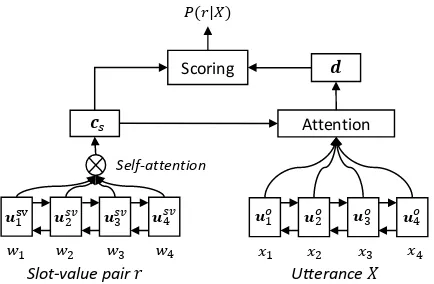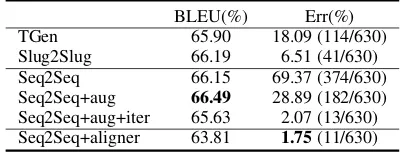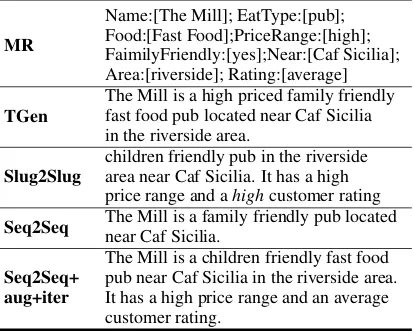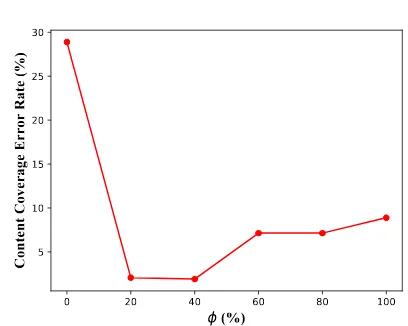2673
A Simple Recipe towards Reducing Hallucination in
Neural Surface Realisation
Feng Nie1∗ Jin-Ge Yao2 Jinpeng Wang2 Rong Pan1 Chin-Yew Lin2 1Sun Yat-Sen University 2Microsoft Research Asia
1fengniesysu@gmail.com, 1panr@sysu.edu.cn
2{jinge.yao, jinpwa, cyl}@microsoft.com
Abstract
Recent neural language generation systems of-tenhallucinatecontents (i.e., producing irrel-evant or contradicted facts), especially when trained on loosely corresponding pairs of the input structure and text. To mitigate this is-sue, we propose to integrate a language under-standing module for data refinement with self-training iterations to effectively induce strong equivalence between the input data and the paired text. Experiments on the E2E chal-lenge dataset show that our proposed frame-work can reduce more than 50% relative un-aligned noise from the original data-text pairs. A vanilla sequence-to-sequence neural NLG model trained on the refined data has improved on content correctness compared with the cur-rent state-of-the-art ensemble generator.
1 Introduction
Neural models for natural language generation (NLG) based on the encoder-decoder framework have become quite popular recently (Wen et al., 2015;Mei et al.,2016;Wiseman et al.,2017;Wen et al.,2017;Chisholm et al.,2017;Nie et al.,2018,
inter alia). Albeit being appealing for producing fluent and diverse sentences, neural NLG models often suffer from a severe issue of content halluci-nation(Reiter,2018a), which refers to the problem that the generated texts often contain information that is irrelevant to or contradicted with the input.
Given that similar issues have been less reported or noticed in the latest neural machine translation systems, we believe that the origin of the issue for neural NLG comes from the data side. Current datasets used for training neural NLG systems of-ten include instances that do not contain the same amount of information from the input structure and the output text (Perez-Beltrachini and Gar-dent, 2017). There is no exception for datasets
∗
Contribution during internship at Microsoft.
MR Name Rating Price Golden Palace 5 out of 5 Cheap
Reference:Golden Palaceis a restaurant specializing in breakfast in thelow price range.
Table 1: A loosely corresponded MR-text pair.Bolded phrases conforms to the MR, underlined words are domain-specific additional information, anditalic val-uesin the MR are not realised in the reference.
originally intended for surface realisation (“how to say”) without focusing on content selection (“what to say”). Table 1 depicts an example, where the attribute Rating=5 out of 5 in the in-put meaning representation (MR) is not verbalised in a reference text written by human, while the word restaurant in the reference should refer to an attribute value EatType=Restaurant not contained in the MR. Without explicit alignments in between MRs and the corresponding utterances for guidance, neural systems trained on such data often produce unexpected errors.
Previous work attempted at injecting indirect semantic control over the encoder-decoder archi-tecture (Wen et al., 2015; Duˇsek and Jurcicek, 2016;Agarwal et al., 2018) or encouraging con-sistency during training (Chisholm et al., 2017), without essentially changing to the noisy train-ing data. One exception is the Slug2Slug system (Juraska et al., 2018), where the authors use an aligner with manually written heuristic rules to fil-ter out unrealized attributes from data.
thresh-olding, conduct self-training to iteratively recover data pairs with identical or equivalent semantics.
Experiments on the E2E challenge benchmark (Novikova et al., 2017b) show that our frame-work can reduce more than 50% relative unaligned noise from original MR-text pairs, and a vanilla sequence-to-sequence model trained on the refined data can improve content correctness in both hu-man and automatic evaluations, when compared with the current state-of-the-art neural ensemble system (Juraska et al.,2018).
2 Approach
Our proposed framework consists of a neural nat-ural language understanding (NLU) module with iterative data refinement to induce semantically equivalent MR-text pairs from a dataset contain-ing a moderate level of noise.
2.1 Notation
Formally, given a corpus with paired meaning rep-resentations and text descriptions {(R, X)}N
i=1, the input MR R = (r1, . . . , rM) is a set of
slot-value pairsrj = (sj, vj), where eachrj contains
a slot sj (e.g., rating) and a value vj (e.g., 5
out of 5). The corpus hasM pre-defined slots , and each slotsj hasKj unique categorical
val-uesvj ∈ (cj,1, . . . , cj,Kj). The corresponding
ut-teranceX= (x1, . . . , xT)is a sequence of words
describing the MR.
2.2 Neural NLU Model
As shown in Figure1, the NLU model consists of a self-attentive encoder and an attentive scorer.
Self-Attentive Encoder. The encoder produces
the vector representations of slot-value pairs in MR and its paired utterance. A slot-value pair r can be treated as a short sequence W = (w1, . . . , wn) by concatenating words in its slot
and value. The word sequence W is first repre-sented as a sequence of word embedding vectors
(v1, . . . ,vn)from a pre-trained embedding matrix
E, and then passed through a bidirectional LSTM layer to yield the contextualized representations Usv = (usv
1 , . . . ,usvn). To produce a summary
context vector for Usv, we adopt the same self-attention structure in Zhong et al. (2018) to ob-tain the sentence vectorcs, due to the effectiveness
of self-attention modules over variable-length se-quences. Similarly, we obtain the contextualized
Name The golden palace
Food English
EatType None
Price Cheap
Rating High
Name The golden palace, …
Food English, French, …
Type Pub, restaurant, …
Price Cheap, high, …
Rating High, low, … 𝑒11
Name
Food
Type
Price
Rating
Discrete latent variable z
Name = The Golden Palace
Self-attention
Attention Scoring
𝑃(𝑟|𝑋)
Slot-value pair 𝑟
Output text 𝒖1sv 𝒖
2
𝑠𝑣 𝒖
3𝑠𝑣 𝒖4𝑠𝑣
The Golden Palace is …
𝒖1𝑜 𝒖2𝑜 𝒖3𝑜 𝒖4𝑜
𝒄𝑠
𝒅
[image:2.595.309.526.62.204.2]𝑤1 𝑤2 𝑤3 𝑤4 𝑥1 𝑥2 𝑥3 𝑥4 Utterance 𝑋
Figure 1: The structure of the neural NLU model.
representations Uo = (uo1, . . . ,uoT) for the utter-anceX.
Attentive Scorer. The scorer calculates the
se-mantic similarity between a slot-value pairr(e.g., Price=Cheap) and the utteranceX (e.g., refer-ence in Table1). Firstly, an attention layer is ap-plied to select the most salient words inXrelated tor, which yields the attentive representationdof utteranceX. Given the sentence vectorcs of the
slot-value pairr and the attentive vectordof the utteranceX, the normalized semantic similarity is defined as:
p(r|X) =softmax(−||d−cs||2), where
d=
T X
t=1
btuot, withbt=softmax((uot)Tcs).
(1)
Model Inference. Each utterance X will be
parsed to an MR Re = (re1, . . . , reM), with each slot-value pairrej = (sj, vj)determined by
select-ing the candidate valuevj with the maximum
se-mantic similarity for each slotsj:
vj =cj,k, k= arg max k
p(rej = (sj, cj,k)|X),
(2) wherecj,kdenotes thekth categorical value forjth
slot. Since an utterance may not describe any in-formation about a specific slots, we add aNONE value as a candidate value of each slot.
Model Training. The NLU model is optimized
by minimizing the cross-entropy loss:
L(θ) =− N X
i M X
j
logp(ri,j|Xi;θ) (3)
where θ denotes model parameters, and ri,j
2.3 Iterative Data Refinement
The performance of NLU can be inaccurate when trained on noisy data-text pairs. However, mod-els trained on data with a moderate level of noise could still be well-calibrated. This could enable an iterative relabeling procedure, where we only take MRs produced by NLU with high confidence together with their utterances as new training MR-text pairs to bootstrap the NLU training.
Algorithm 1 describes the training procedure. We first pre-train the NLU model using the orig-inal data-text pairs forNpre iterations. Then the
NLU model parses relevant MR for every utter-ance in training data, which can be used as new training examples (Line 4). However, due to the inaccuracy of the NLU results, we only use a small portion (φis set to 40% on validation) with high confidence. Moreover, as each MR consists of up toMslots with some of them being unreliable, we filter the slot-value pairs with slot probability be-low average according to slot confidence (Line8 -14). Finally, the NLU model is fine-tuned with the new training corpusDe. This process is repeated forNtuneepochs. The final NLU model is
lever-aged to parse all utterances in the training corpus. The resulting MRs paired with original utterances form the refined training corpus for NLG.
3 Experiments
3.1 Setup
Dataset. Our experiments are conducted on E2E
challenge (Novikova et al.,2017b) dataset, which aims at verbalizing all information from the MR. It has 42,061, 4,672 and 4,693 MR-text pairs for training, validation and testing, respectively. Note that every input MR in this dataset has 8.65 dif-ferent references on average. The test set has 630 unique input MRs. We examine the effectiveness of our proposed method in two aspects: 1) reduc-ing the noise in data-text pairs (NLU), 2) reducreduc-ing hallucinated contents in surface realisation (NLG).
Automatic metrics. The well-crafted rule-based
aligner built by Juraska et al. (2018)1 is adopted to approximately reflect the semantic correctness of NLU and NLG models. The error rate is cal-culated by matching the slot values in output ut-terance: Err = MN, whereN is the total number
1 We use the public available evaluation script in
https://github.com/jjuraska/slug2slug/blob/master/slot aligner /data analysis.py
Algorithm 1Iterative Data Refinement
Require MR-text pairs D = {(R, X)}N
1 , confi-dence thresholdφ, pre-training epochsNpre,
tun-ing epochsNtune,
1: Trainθwith Eq.3onDforNpreiterations
2: foriter= 1 toNtunedo
3: Reset self-training corpusDe ={}
4: Parse the MRRei = (ri,e1, . . . , rei,M)for ev-eryXiusing Eq.2
5: Slot confid. pj =PNi=1p(rei,j|Xi)forsj
6: MR confid.fi=PMj=1p(ri,je |Xi)forRei
7: Sort{(Re, X)}N
1 by MR confidence in re-verse order
8: fori= 1 tobφ·Ncdo
9: forj= 1 toM do
10: ifp(rei,j|Xi)< pj/N then
11: Removerei,jfromRei
12: end if
13: end for
14: De ←De∪(Rei, Xi)
15: end for
16: Updateθwith Eq.3onDe
17: end for
of MR-text pairs, andM is the number of wrong MR-text pairs which contain missing or conflict slots in the realization given its input MR. BLEU-4 (Papineni et al.,2002) is also reported, although currently neither BLEU nor any other automatic metrics could be convincingly used for evaluating language generation (Novikova et al.,2017a; Cha-ganty et al.,2018;Reiter,2018b,inter alia).
Human Evaluation. We randomly sample 100
data-text pairs from test set and ask three crowd workers to manually annotatemissed (M),added
(A), andcontradicted(C) slot values in NLG out-puts with respect to the input MR, orexact match
(E) if all slot values have been realized in the given utterance which contains no additional hal-lucinated information. When evaluating the NLU systems,missedandaddedslots refer to the oppo-site directions, respectively.
Compared Systems. Systems in comparison:
• TGen (Duˇsek et al., 2018): a sequence-to-sequence (Seq2Seq) model with reranking.
• Seq2Seq: a basic Seq2Seq model trained on original MR-text pairs with the copy mecha-nism (Gu et al.,2016;See et al.,2017).
• Seq2Seq+aug:Seq2Seqtrained on the MR-text pairs reconstructed by pre-trained NLU.
• Seq2Seq+aug+iter: Seq2Seqtrained on the MR-text pairs reconstructed by NLU model with iterative data refinement algorithm.
• Seq2Seq+aligner: Seq2Seq trained on the MR-text pairs produced by the rule based aligner (Juraska et al.,2018).
Implementation Details. For all models, we use
fixed pre-trained GloVe vectors (Pennington et al., 2014) and character embeddings (Hashimoto et al., 2017). The dimensions of trainable hid-den units in LSTMs are all set to 400. The epochs for pre-trainingNpreand bootstrappingNtuneare
all set to 5 on validation. During training, we regularize all layers with a dropout rate of 0.1. We use stochastic gradient descent (SGD) for op-timisation with learning rate 0.1. The gradient is truncated by 5. For hyper-parameter φ, we conduct experiments with different values (φ = 0.2,0.4,0.6,0.8,1.0), details in Appendix A.
3.2 Main Results
NLU Results. One challenge in E2E dataset is
the need to account for the noise in the corpus as some of the MR-text pairs are not semanti-cally equivalent due to the data collection pro-cess (Duˇsek et al., 2018). We examine the per-formance of the NLU module by comparing noise reduction of the reconstructed MR-text pairs with the original ones in both training and test sets. Table 2 shows the automatic results. Applying our NLU model with iterative data refinement, the error rates of refined MR-text pairs yields 23.33% absolute error reduction on test set. Hu-man evaluation in Table3shows that our proposed method achieves 16.69% improvement on infor-mation equivalence between MR-text pairs. These results confirm the effectiveness of our method in reducing the unaligned data noise, and the large improvement (i.e, 15.09%) on exact match when applying self-training algorithm suggests the im-portance of iterative data refinement.
NLG Results. Table4presents the automatic
re-sults of different neural NLG systems. We can see that Seq2Seq+aug+iter achieves com-parable BLEU score as Slug2Slug but with 4.44% error reduction on content correctness over
Train Err(%) Test Err(%) Original data 35.50 37.59 NLU refined data 16.31 14.26
[image:4.595.322.510.64.108.2]w/o self-training 25.14 22.69
Table 2: Automatic evaluation results of different NLU models on both training and test sets
[image:4.595.315.517.254.330.2]E(%) M(%) A(%) C(%) Original data 71.93 0 24.13 3.95 NLU refined data 88.62 5.45 2.48 3.47 w/o self-training 73.53 13.23 8.33 4.91
Table 3: Human evaluation results for NLU on test set (inter-annotator agreement: Fleiss’ kappa = 0.855)
[image:4.595.313.520.369.423.2]BLEU(%) Err(%) TGen 65.90 18.09 (114/630) Slug2Slug 66.19 6.51 (41/630) Seq2Seq 66.15 69.37 (374/630) Seq2Seq+aug 66.49 28.89 (182/630) Seq2Seq+aug+iter 65.63 2.07 (13/630) Seq2Seq+aligner 63.81 1.75(11/630)
Table 4: Automatic metrics for NLG
E(%) M(%) A(%) C(%) TGen 78.49 15.12 2.69 3.3 Slug2Slug 91.36 2.98 0 5.66 Seq2Seq 44.07 50.65 4.03 0.65 Seq2Seq+aug+iter 93.93 3.36 2.69 0
Table 5: Human evaluation results for NLG (inter-annotator agreement: Fleiss’ kappa = 0.832)
Slug2Slug. Seq2Seq+aug+iter largely improves the content correctness over the base-line Seq2Seqwith 67.3% error reduction. Be-sides, we also replace our NLU module with the rule based aligner crafted by Juraska et al. (2018) for data refinement to inspect the differ-ence between our proposed method and manu-ally designed rich heuristics. We can observe that these two models (Seq2Seq+aug+iter and Seq2Seq+aligner) achieve comparable per-formance, while our approach is fully automatic and requires no domain knowledge.
con-Utterance: Located in riverside, near Caf Sicilia, is the Phoenix, a French pub that is family-friendly and has average prices and an average rating.
Original MR: name[The Phoenix], eatType[pub], food[French], priceRange[20-25], area[riverside], customer rating[3 out of 5], familyFriendly[no], near[Caf Sicilia]
[image:5.595.80.287.230.396.2]Refined MR: name[The Phoenix], eatType[pub], food[French], priceRange[moderate], area[riverside], customer rating[average], familyFriendly[yes], near[Caf Sicilia]
Table 6: Example for data refinement; The underscored item is incorrect.
MR
Name:[The Mill]; EatType:[pub]; Food:[Fast Food];PriceRange:[high]; FaimilyFriendly:[yes];Near:[Caf Sicilia]; Area:[riverside]; Rating:[average]
TGen
The Mill is a high priced family friendly fast food pub located near Caf Sicilia in the riverside area.
Slug2Slug
children friendly pub in the riverside area near Caf Sicilia. It has a high price range and ahighcustomer rating
Seq2Seq The Mill is a family friendly pub located
near Caf Sicilia.
Seq2Seq+ aug+iter
The Mill is a children friendly fast food pub near Caf Sicilia in the riverside area. It has a high price range and an average customer rating.
Table 7: Examples of different system outputs.
tradicted errors. Our method can complement and correct original MR with additional slot values de-scribed in the paired texts to effectively alleviate generating contradicted facts. However, due to the imperfection of NLU model, our method may ig-nore part of slot values realized in utterances and produce some additional errors.
3.3 Case Study
Example for refined data. Table 6 depicts a
case for one pair with originally inaccurate MR while being corrected by NLU module and itera-tive refinement. Our proposed method is capable of reducing the unaligned noise for original data.
Example for NLG. Table 7shows the sentences
generated by different NLG systems. Seq2Seq without any semantic control tends to generate shorter descriptions.Slug2SlugandTGenwith reranker to control the content coverage can gen-erate more input information, but still misses one input information and Slug2Slug produces a contradicted fact (i.e., customer rating). Our pro-posed methodSeq2Seq+aug+itertrained on
refined MR-text pairs, verbalises all the input in-formation correctly, which shows the importance of data quality in terms of strong equivalence be-tween MR and utterance.
4 Discussion
In this paper, we present a simple recipe to re-duce the hallucination problem in neural language generation: introducing a language understanding module to implement confidence-based iterative data refinement. We find that our proposed method can effectively reduce the noise in the original MR-text pairs from the E2E dataset and improve the content coverage for standard neural surface realisation (no focus on content selection).
However, the currently presented approach still has two clear limitations. One is that this simple approach is implicitly built on an assumption of a moderate level of noise in the original data, which makes it possible to bootstrap a well-calibrated NLU module. We are still on the way to find out solutions for cases with huge noise (Perez-Beltrachini and Lapata, 2018; Wiseman et al., 2017), where heavy manual intervention or exter-nal knowledge should be desperately needed.
The other limitation of this preliminary work is that it currently overlooks the challenges of lexical choices for quantities, degrees, temporal expres-sions, etc, which are rather difficult to learn merely from data and should require additional common-sense knowledge. An example case is in Table6, where the original priceRange=20-25 is re-fined to be priceRange=moderate, which enhances the correspondence between the MR and the text but sidesteps the lexical choice for num-bers which requires localised numerical common-sense. Additional modules for lexical choices should be expected for a refined system.
5 Acknowledgement
References
Shubham Agarwal, Marc Dymetman, and Eric Gaussier. 2018. Char2char generation with
rerank-ing for the E2E NLG challenge. In Proceedings
of the 11th International Conference on Natural Language Generation, pages 451–456, Tilburg Uni-versity, The Netherlands. Association for Computa-tional Linguistics.
Arun Chaganty, Stephen Mussmann, and Percy Liang. 2018. The price of debiasing automatic metrics in natural language evalaution. In Proceedings of the 56th Annual Meeting of the Association for Com-putational Linguistics (Volume 1: Long Papers), pages 643–653, Melbourne, Australia. Association for Computational Linguistics.
Andrew Chisholm, Will Radford, and Ben Hachey. 2017. Learning to generate one-sentence
biogra-phies from Wikidata. In Proceedings of the 15th
Conference of the European Chapter of the Associa-tion for ComputaAssocia-tional Linguistics: Volume 1, Long Papers, pages 633–642, Valencia, Spain. Associa-tion for ComputaAssocia-tional Linguistics.
Ondˇrej Duˇsek and Filip Jurcicek. 2016. Sequence-to-sequence generation for spoken dialogue via deep syntax trees and strings. InProceedings of the 54th Annual Meeting of the Association for Computa-tional Linguistics (Volume 2: Short Papers). Asso-ciation for Computational Linguistics.
Ondˇrej Duˇsek, Jekaterina Novikova, and Verena Rieser. 2018. Findings of the E2E NLG challenge. In
Proceedings of the 11th International Conference on Natural Language Generation, pages 322–328, Tilburg University, The Netherlands. Association for Computational Linguistics.
Jiatao Gu, Zhengdong Lu, Hang Li, and Victor O.K. Li. 2016. Incorporating copying mechanism in sequence-to-sequence learning. In Proceedings of the 54th Annual Meeting of the Association for Com-putational Linguistics (Volume 1: Long Papers), pages 1631–1640, Berlin, Germany. Association for Computational Linguistics.
Kazuma Hashimoto, Caiming Xiong, Yoshimasa Tsu-ruoka, and Richard Socher. 2017. A joint many-task model: Growing a neural network for multiple NLP
tasks. In Proceedings of the 2017 Conference on
Empirical Methods in Natural Language Process-ing, pages 1923–1933, Copenhagen, Denmark. As-sociation for Computational Linguistics.
Juraj Juraska, Panagiotis Karagiannis, Kevin Bowden, and Marilyn Walker. 2018. A deep ensemble model with slot alignment for sequence-to-sequence natu-ral language generation. InProceedings of the 2018 Conference of the North American Chapter of the Association for Computational Linguistics: Human Language Technologies, Volume 1 (Long Papers), pages 152–162, New Orleans, Louisiana. Associa-tion for ComputaAssocia-tional Linguistics.
Hongyuan Mei, Mohit Bansal, and Matthew R. Walter. 2016. What to talk about and how? selective gen-eration using LSTMs with coarse-to-fine alignment. InProceedings of the 2016 Conference of the North American Chapter of the Association for Computa-tional Linguistics: Human Language Technologies, pages 720–730, San Diego, California. Association for Computational Linguistics.
Feng Nie, Jinpeng Wang, Jin-Ge Yao, Rong Pan, and Chin-Yew Lin. 2018. Operation-guided neu-ral networks for high fidelity data-to-text genera-tion. In Proceedings of the 2018 Conference on Empirical Methods in Natural Language Process-ing, pages 3879–3889, Brussels, Belgium. Associ-ation for ComputAssoci-ational Linguistics.
Jekaterina Novikova, Ondˇrej Duˇsek, Amanda Cer-cas Curry, and Verena Rieser. 2017a. Why we
need new evaluation metrics for NLG. In
Proceed-ings of the 2017 Conference on Empirical Methods in Natural Language Processing, pages 2241–2252, Copenhagen, Denmark. Association for Computa-tional Linguistics.
Jekaterina Novikova, Ondˇrej Duˇsek, and Verena Rieser. 2017b. The E2E dataset: New challenges for end-to-end generation. InProceedings of the 18th An-nual SIGdial Meeting on Discourse and Dialogue, pages 201–206, Saarbr¨ucken, Germany. Association for Computational Linguistics.
Kishore Papineni, Salim Roukos, Todd Ward, and Wei-Jing Zhu. 2002. BLEU: a method for automatic
evaluation of machine translation. InProceedings
of 40th Annual Meeting of the Association for Com-putational Linguistics, pages 311–318, Philadelphia, Pennsylvania, USA. Association for Computational Linguistics.
Jeffrey Pennington, Richard Socher, and Christopher Manning. 2014. Glove: Global vectors for word
representation. In Proceedings of the 2014
Con-ference on Empirical Methods in Natural Language Processing (EMNLP), pages 1532–1543, Doha, Qatar. Association for Computational Linguistics.
Laura Perez-Beltrachini and Claire Gardent. 2017.
Analysing data-to-text generation benchmarks. In
Proceedings of the 10th International Conference on Natural Language Generation, pages 238–242, San-tiago de Compostela, Spain. Association for Com-putational Linguistics.
Laura Perez-Beltrachini and Mirella Lapata. 2018.
Bootstrapping generators from noisy data. In
Pro-ceedings of the 2018 Conference of the North Amer-ican Chapter of the Association for Computational Linguistics: Human Language Technologies, Vol-ume 1 (Long Papers), pages 1516–1527, New Or-leans, Louisiana. Association for Computational Linguistics.
Ehud Reiter. 2018b.A structured review of the validity
of BLEU. Computational Linguistics, 44(3):393–
401.
Abigail See, Peter J. Liu, and Christopher D. Manning. 2017.Get to the point: Summarization with pointer-generator networks. InProceedings of the 55th An-nual Meeting of the Association for Computational Linguistics (Volume 1: Long Papers), pages 1073– 1083, Vancouver, Canada. Association for Compu-tational Linguistics.
Tsung-Hsien Wen, Milica Gasic, Nikola Mrkˇsi´c, Pei-Hao Su, David Vandyke, and Steve Young. 2015.
Semantically conditioned LSTM-based natural
lan-guage generation for spoken dialogue systems. In
Proceedings of the 2015 Conference on Empirical Methods in Natural Language Processing, pages 1711–1721, Lisbon, Portugal. Association for Com-putational Linguistics.
Tsung-Hsien Wen, David Vandyke, Nikola Mrkˇsi´c, Milica Gasic, Lina M. Rojas Barahona, Pei-Hao Su, Stefan Ultes, and Steve Young. 2017. A network-based end-to-end trainable task-oriented dialogue
system. InProceedings of the 15th Conference of
the European Chapter of the Association for Compu-tational Linguistics: Volume 1, Long Papers, pages 438–449, Valencia, Spain. Association for Compu-tational Linguistics.
Sam Wiseman, Stuart Shieber, and Alexander Rush. 2017. Challenges in data-to-document generation. In Proceedings of the 2017 Conference on Empiri-cal Methods in Natural Language Processing, pages 2253–2263, Copenhagen, Denmark. Association for Computational Linguistics.
Victor Zhong, Caiming Xiong, and Richard Socher. 2018. Global-locally self-attentive encoder for dia-logue state tracking. InProceedings of the 56th An-nual Meeting of the Association for Computational Linguistics (Volume 1: Long Papers), pages 1458– 1467, Melbourne, Australia. Association for Com-putational Linguistics.
0 20 40 60 80 100
5 10 15 20 25 30
[image:7.595.310.514.68.231.2]&RQWHQW&RYHUDJH(UURU5DWH
Figure 2: The effect of hyperparameterφfor NLG con-tent coverage performance.
A Effect ofφon NLG model



